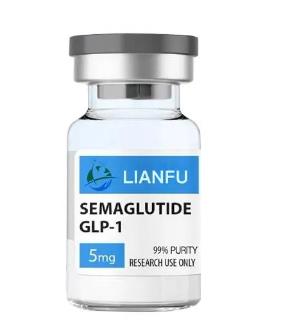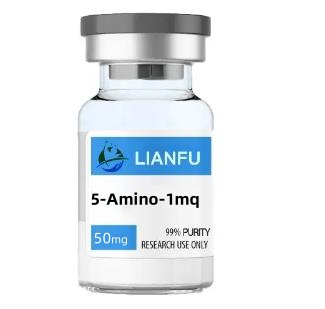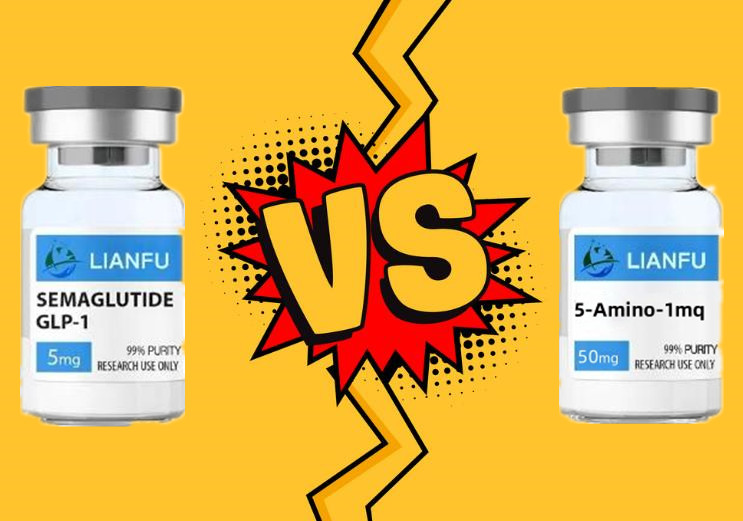Two compounds, semaglutide and 5-amino-1mq, have gained attention in weight management and metabolic health.
Let’s see how they work.
How Does Semaglutide Work?
It turns on GLP-1 receptors in the gut, pancreas, and brain, which leads to several effects. Semaglutide boosts insulin release based on glucose levels, slows down stomach emptying, and cuts back on glucagon production . These actions help control blood sugar and reduce hunger.
Semaglutide influences hypothalamic receptors in the brain to reduce hunger, limit food cravings, and boost feelings of fullness. Its long half-life allows patients to administer it once a week. This is because changes to its structure help it bind to albumin and protect it from breaking down. When people use semaglutide weekly, it reaches steady levels in the blood after 4 to 5 week.
Semaglutide typically begins to suppress appetite within a few days to a week of starting the medication, with more noticeable effects developing over the first few weeks.
Sticking to semaglutide safety guidelines will help you cut down on possible side effects and get the best results as you work to manage your weight.
By mimicking a natural hormone that controls hunger and blood sugar, semaglutide tablets work by helping people manage their weight by reducing food cravings. Semaglutide comes in pill form, as a sublingual suspension, and as an injection. Each type has its pros and cons, and there are several factors to consider when deciding between semaglutide tablets vs injections.
Compounded semaglutide can be used when tailored dosing or specific formulations are needed that aren’t available in standard prescriptions, offering more flexibility for individual patient needs. It’s important to consult with a healthcare provider to ensure the compounded version is safe, effective.
How Does 5-Amino-1mq Work?
If you’re considering semaglutide alternatives, options like 5-amino-1mq or other GLP-1 receptor agonists might be effective for weight management and blood sugar control. 5-Amino-1MQ targets a specific enzyme called Nicotinamide N-methyltransferase (NNMT). As people gain weight, their fat cells grow bigger, which leads to more NNMT production. This enzyme has an impact on fat cell metabolism, making it tougher for cells to burn fat.
5-Amino-1MQ, a small molecule that can pass through cell membranes, stops too much NNMT from being made . Lowering NNMT levels helps the body keep burning fat well and stops fat cells from growing more.
This compound works without having an effect on other enzymes, which reduces the chance of unwanted reactions . Studies indicate that 5-Amino-1MQ leads to a decrease in body weight, white fat mass, and fat cell size while also lowering total cholesterol in the blood . It does all this without changing how much food is eaten . By blocking NNMT, 5-Amino-1MQ boosts the levels of NAD+ and S-(5′-adenosyl)-L-methionine (SAM) inside cells, which stops fat production in fat cells .
5-Amino-1mq VS Semaglutide
5-Amino-1MQ and semaglutide take different paths to help manage weight. 5-Amino-1MQ stops NNMT, which boosts NAD+ levels and how cells use energy. It helps burn fat but keeps muscle, which could help people with type II diabetes. Semaglutide, which the FDA has approved, acts like the GLP-1 hormone to make more insulin and cut hunger.
Both show hope for weight loss, and doctors have seen semaglutide work well in tests. It’s essential to understand semaglutide dosages and guidelines. Researchers need to study more about how 5-Amino-1MQ works in humans. If you’re thinking about these options, talk to a doctor to figure out what’s best for your specific health needs.
FAQ
Can You Take Semaglutide And 5-Amino-1mq Together?
There is currently no clinical evidence on the safety or efficacy of combining semaglutide with 5-Amino-1mq. Before considering any combination of treatments, it is crucial to consult with a healthcare provider to evaluate potential risks and benefits.
Do Semaglutide And 5-Amino-1mq Work Differently?
Yes, semaglutide and 5-Amino-1mq work through distinct mechanisms. Semaglutide stimulates GLP-1 receptors, regulating appetite and food intake. It increases insulin secretion and improves glycemic control. In contrast, 5-Amino-1mq blocks NNMT, preventing metabolism slowdown and promoting fat burning while preserving muscle mass. This difference in action makes each compound suitable for different aspects of weight management and metabolic health.
Post time: Dec-25-2024









